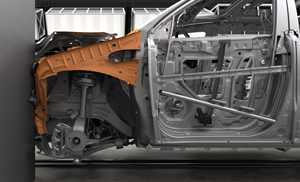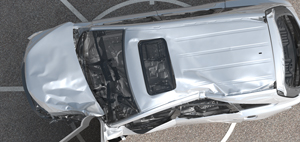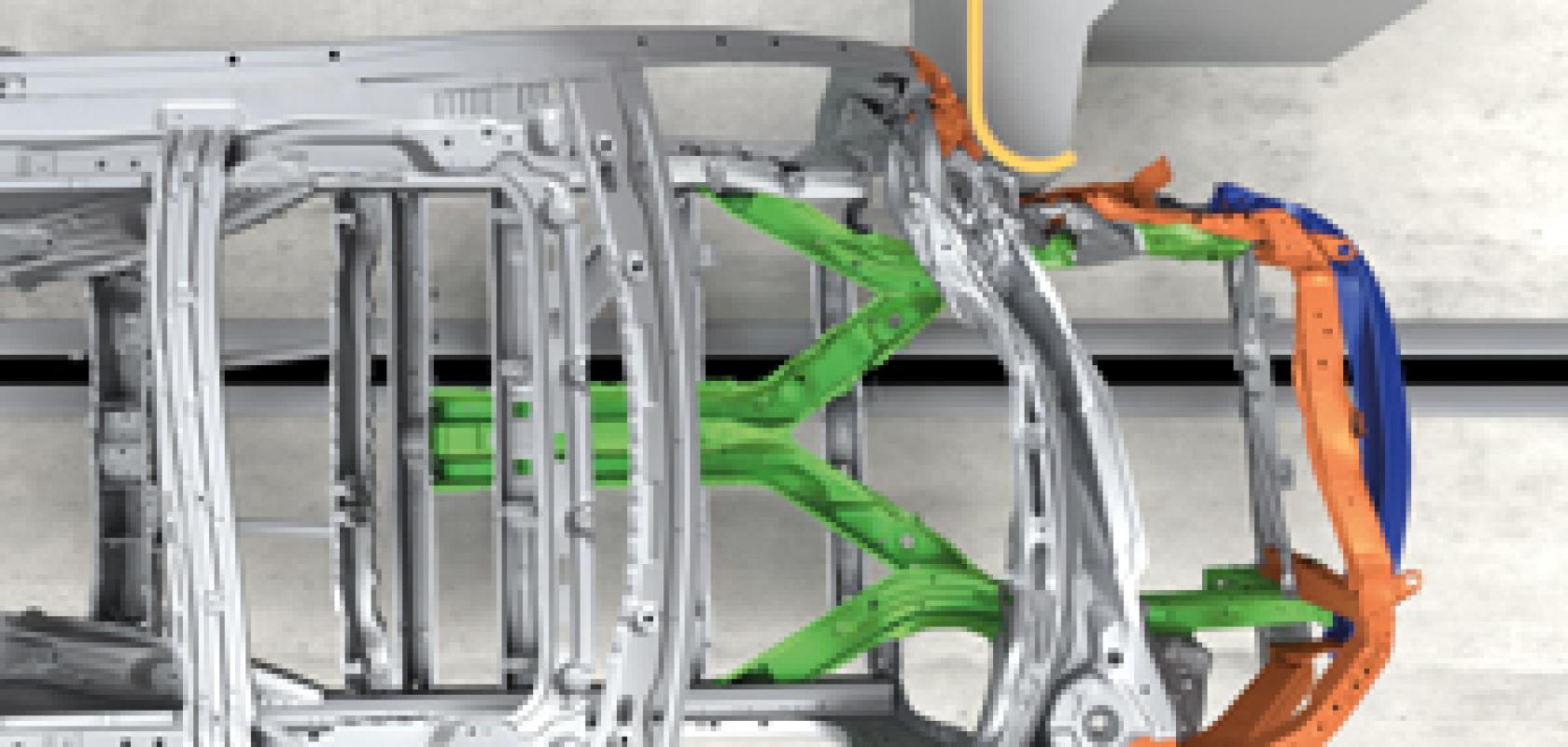Simulation allows engineers to shorten product development times significantly by reducing the need for physical testing. Simulation is particularly important to the automotive industry as it must meet strict regulations on the performance of vehicles under crash conditions.
Early crash simulations have been around since the 1980’s but, at that time, they were constrained by the computer hardware available. Laurent Di Valentin, senior CAE expert for the PSA Group, explained that while early models were much simpler, PSA group and many similar commercial organisations have been using simulation for many years because of the competitive advantage it offers.
Valentin explained: ‘We [PSA Group] invest in simulation because it provides us with a result that can reduce the need for testing and prototypes, which significantly reduces the development time of the project. We accepted that there was a need to invest in HPC servers to get these results.’
PSA group is a French multinational manufacturer of automobiles and motorcycles sold under the Peugeot, Citroën and DS Automobiles brands.
Crash simulation software has improved greatly over the last 30 years, to the point that it is now beginning to replace physical testing and validation. This has become possible thanks to much larger, more accurate simulations, sometimes containing millions of elements. These simulations can recreate sophisticated physics and simulate material properties, allowing automotive companies to validate new vehicles and components with less physical testing.
For Dassault Systèmes, this has meant considerable research and product development in making their simulations a realistic as possible, both in terms of the physics involved and the visualisation of results.
Dale Berry, senior director SIMULIA product experience technical from Dassault Systèmes, commented that ‘there has been a tremendous amount of development in this software field to be sure that these models are realistic. It doesn’t do anyone any good if these software models cannot recreate accurate physics.’
‘It is really about making sure that your design is right the first time so that, when you do go and build a prototype you can physically test, you know it will pass certification testing and you can go straight into production,’ stated Berry.
Recreating real world physics can be incredibly computationally intensive. This is because recreating material deformation requires incredibly detailed models with a fine grain mesh. This is especially true for crash simulation as small material defects – introduced in manufacturing – can cause unwanted effects during a crash.
One aspect of this that Altair and PSA have been investigating is rupture and buckling of materials under crash conditions.
Altair’s Di Valentin explained that, to model rupture properly, you need both a well-defined model that can both predict the failure of parts accurately, and also a very fine mesh that is ‘able to detect the start of a failure and its propagation through a material.’
Di Valentin gave an example of a project to optimise the development of a B-pillar, which is a vertical pillar connecting the roof and the base of a car: ‘For this component, we have 15,000,000 elements to simulate rupture.’ Di Valentin explained that the project was particularly useful as it gave an opportunity for Altair to test the capability of RADIOSS on large-scale HPC systems, while also improving PSA’s knowledge on the propagation of material failure.
The project was run on the Curie supercomputer, owned by GENCI and operated by The French Alternative Energies and Atomic Energy Commission (Commissariat à l’énergie atomique et aux énergies alternatives) or CEA.
Jean Michelle Terrier, Altair vice president of RADIOSS business and research and development stated that access to the CEA supercomputer was provided through the Partnership for Advanced Computing in Europe (PRACE).
The model describing rupture used in this project was created through the ‘Industrial Fracture Consortium,’ which included members from MIT, Ecole Polytechnique and industrial partners like PSA.
‘Today cars are quite complex,’ commented Terrier. ‘You have a lot of lightweight materials such as aluminium, magnesium, composites and plastics – and you also have high strength steel, which has a very specific behaviour.’
Terrier explained that working with these relatively new materials requires OEMs to investigate new material laws that can correctly model the behaviour of plastics, or of composites, for example. These studies help software providers and commercial companies to develop numerical tools and design rules that can support the use of new materials – accurately predicting material failures.
The aim of the Altair/PSA project was to improve their ability to assess predictive rupture models, and to identify a viable solution for testing ruptures on a massive scale.
First, Altair engineers ported RADIOSS to Bullxmpi for the Curie supercomputer. Then, two specific models were developed to study rupture of a B-pillar component, with mesh size requirement of 75µm element length.
The first model – created by Altair, with 15 million of elements – was used to assess scalability of the code up to 8,192 cores. A second model was built by PSA, with mesh optimisation reducing element number to 10 million.
Employing optimisation in crash simulation
These tools are used not only by commercial vehicle manufacturers but also in academia as Jingwen Hu, an associate research scientist at the University of Michigan Transportation Research Institute Biosciences Group explains. Hu stated that he had been using simulation for around 18 years, but first discovered Esteco through a seminar at Wayne State University, where he was pursuing his master’s degree in engineering.
Hu stated that, approximately 10 years ago, he saw a seminar at the university about optimising crash simulation using modeFrontier. Hu explained that he had been using the software since that time because of its ease of use, and of the work that Esteco put into providing support for its users.
Esteco’s modeFrontier software is designed to facilitate multidisciplinary optimisation. This can be particularly useful in crash simulation, as it allows hundreds or thousands of variations of a model to be simulated – automating the process of optimising the design based on pre-selected parameters
Jingwen Hu explained that some of his recent research has focused on the optimisation of seatbelt restraints using Estceco’s modeFrontier software. He discussed two projects to improve crash safety; the first focused on the seatbelt interlock, a US requirement that prevents engine ignition if the front seatbelt is not fastened.
This study investigated the viability of removing the unbelted regulation if seatbelt interlocks are available in US vehicles. The second project investigated crash safety in the rear of the vehicle; the study focused on the protection afforded by seat restraint systems on a diverse population of passengers, from adults to infants in a booster seat.
For this study, the researchers created models of response surface methods (RSM) to optimise the variables of the restraint system, allowing them to simulate thousands of potential variations. The results show that removing the unbelted requirement in the US regulation would allow automotive manufacturers to optimise seat restraints for belted occupants (around 86 per cent of drivers in the US) better.
‘This regulation decreases the protection of people that wear the seatbelt’ continued Hu. ‘If we removed this regulation, then people who wear the seatbelt would have better protection. But, you might not have an overall benefit of injury reduction because, as you improve the protection for the belted occupants, you decrease protection for the unbelted occupants.
The second study focused on the optimisation of seat restraints in the rear of a car based on a diverse population of occupants. Hu explained: ‘For the people who do sit in the rear seat we have a very diverse population. In the front seat typically, it is adults, but in the rear seats we have a lot of kids, including those that will sit in the booster seat.’
Those children in booster seats are often well protected by the position of the booster seat, which is optimised around small children. However, children in the range of six- to 12-year-olds often cannot use seatbelts correctly, so this study was aimed at optimising seat restraints for these occupants.
‘This study looks at whether we can change the rear seat stiffness, cushion length and the seatbelt anchorage locations to protect older children better,’ commented Hu.

Simulation of a crash using Deltagen Real Impact Visualisation.
This study demonstrates that there is no single solution for all rear seat occupants, as each population is optimised in different ways. ‘Older kids will be better protected by a shorter seat cushion, while infants in the car seat will benefit most from a longer seat cushion. At the same time, with the seatbelt anchorage position, the older children will benefit most with a more forward anchorage location, whereas an infant will benefit most from a rearward anchorage position.’
Ultimately, Hu and his colleagues found that there was no single system that could protect all occupants. ‘What we recommend is that, in the future, there will need to be some adjustable or adaptive features’ concluded Hu.
Empowering design
While much of the focus in simulation is on creating more powerful solvers with additional functionality, that is not the only area of development for crash simulation. Equally as important is the time and money spent on developing tools to facilitate understanding and share information across both design and engineering teams.
One aspect of this is the combination of traditional FEA with powerful visualisation tools that can demonstrate the simulation.
Dassault’s Berry explains: ‘The vision is to put this technology from SIMULIA, 3d Excite, Catia and others onto what is called a 3D experience platform.’
By combining tools that can provide the engineering precision and accuracy with the visualisation capabilities and real-time interaction of DS’ 3D Excite, Deltagen provides a much more user-friendly experience for users who are not experts in mechanical engineering.
‘When we put this information into the 3D experience platform, it allows us to take simulation and spread it beyond just the engineering department. The promise is to bring these products together and expose simulation and its values to a much wider audience,’ explained Berry.
The future of simulation
In the opinion of Berry, one way that companies like Dassault Systèmes can help to alleviate the challenges of increasing complexity is to help facilitate the use of simulation tools to a wider audience.
‘The democratisation of engineering tools is where DS is headed. I think it is where the whole simulation industry is headed’ said Berry.
‘The use of tools like Abaqus has been successful and, even though they are specialist tools, they have still had a very broad reach. Now business leaders – not just the engineering leaders – are starting to take notice.’

High quality visualisation allows engineers to predict simulation results intuitively.
Future development of simulation tools
Another aspect of simulation that will continue to drive a need for more computing power will be the increasing size of simulations. The project run by PSA and Altair is an example of some of the largest crash simulations, but Di Valentin expects that this will become much more frequent in the future: ‘It is true that it is not common to use 8,000 cores, but it is something that we see will come very quickly, because the size of HPC systems is growing.’
Di Valentin commented that, between three and five years, ‘we will have more and more models with 25,000,000 million elements because of a need to go into higher detail for some simulations.’
‘We can model many things, but we have some physical phenomena which are very important in crash simulation. We are not capable of modelling these things correctly’ said Laurent.
‘The main problem we have is rupture’ said Laurent. He explained that a crash causes ruptures of many components that all act differently, based on material composition and the forces and strain involved in the crash.
To overcome these challenges Altair and PSA are investing heavily in developing the potential of crash simulation. This involves developments in the ability to scale software to higher numbers of cores, as well as integrating new software factors that can more accurately predict material behaviours.
Terrier commented that Altair is already working on new capabilities that will further improve crash simulation. One such example is the acquisition of Click2Cast, a simulation tool used to emulate the casting process of new materials.
Altair acquired Click2Cast in 2015 and has already integrated the software into its HyperWorks software portfolio. Terrier commented that Altair is now working to integrate the software so that it can be coupled with RADIOSS, providing more detailed analysis of both the casting processes and any potential material defects imposed through the creation of new components.
Terrier predicted that the process of coupling Click2Cast to RADIOSS would take between 12 and 18 months.
Simulation enables new insights
While simulation can shorten product development times and reduce costs, simulations are now creating new insights into component behaviour that cannot be derived from traditional physical testing.
Laurent gave two examples from the B-pillar project: the thickness variation of material, and the plastic strain on the part during the crash. Laurent explained that characterising the potential material deformations would be too time-consuming and costly, while understanding material strain cannot be acheived without the use of simulation.
Laurent gave an example of a gearbox or engine mount that links the engine and gearbox to the structure in the front of the car. ‘
To check the timing of the rupture of the gearbox mount is very important in the crash scenario, said Laurent, adding: ‘We know precisely when the rupture starts inside the gearbox mount.
‘This information is not easy to analyse in a full car crash.’
Laurent explained that a physical test could give you an idea of when something has broken, but not pinpoint the time and start of a rupture accurately.
‘The information that this simulation is able to provide to us is extremely important for improving or validating the design,’ concluded Laurent.


